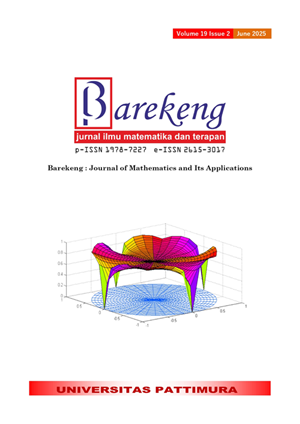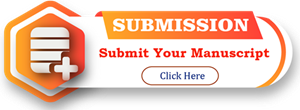A MACHINE LEARNING FRAMEWORK FOR SUICIDAL THOUGHTS PREDICTION USING LOGISTIC REGRESSION AND SMOTE ALGORITHM
Abstract
Suicide, a global health challenge identified in Goal 3 of the global agenda for enhancing worldwide well-being, demands urgent attention. This study focused on predicting suicidal thoughts using machine learning, leveraging the 2021 National Women's Life Experience Survey (SPHPN) involving women aged 15 to 64. Analyzing 11,305 ever-married women, 504 (4.5%) reported experiencing suicidal thoughts. The outcome variable was binary (1 for suicidal thoughts, 0 for none). The study used seven predictors: age, education level, residence type, physical and sexual violence, smoking frequency, alcohol consumption, and depression. Ordinary logistic regression and SMOTE-based logistic regression were applied. The former identified physical violence, depression, and sexual violence as crucial factors, while the latter emphasized physical violence, sexual violence, and age. In cases of class imbalance, the SMOTE-enhanced model exhibited improved performance in terms of sensitivity, false positive rate, balanced accuracy, and Kappa statistic, with lower standard errors of parameter estimates. The findings highlight the importance of addressing violence and mental health in policies aimed at reducing suicidal thoughts among women. Policymakers can use these insights to develop targeted interventions, and healthcare providers can identify high-risk individuals for timely interventions. Community programs and public health campaigns should promote mental well-being and prevent suicidal behaviors using these findings. Future research should include more predictors, diverse populations, and longitudinal data to better understand causal relationships and timing. Interdisciplinary collaboration and advanced machine learning techniques can enhance predictive accuracy and model interpretability.
Downloads
References
World Health Organization, "Suicide," World Health Organization, 2024. [Online]. Available: https://www.emro.who.int/health-topics/suicide/feed/atom.html. [Accessed 15 October 2024].
World Health Organization, "Suicide worldwide in 2019: Global Health Estimates," 2021.
E. D. Klonsky, A. M. May and B. Y. Saffer, "Suicide, Suicide Attempts, and Suicidal Ideation," Annual Review of Clinical Psychology, vol. 12, pp. 307-330, 2016.
World Health Organization, "Mental Health, Brain Health and Substance Use," World Health Organization, June 2021. [Online]. Available: https://www.who.int/teams/mental-health-and-substance-use/data-research/suicide-data. [Accessed 15 October 2024].
World Health Organization, "SDG Target 3.4 Non-communicable diseases and mental health," 2024. [Online]. Available: https://www.who.int/data/gho/data/themes/topics/sdg-target-3_4-noncommunicable-diseases-and-mental-health. [Accessed 2024 October 2024].
T. Joiner and M. D. Rudd, Suicide Science: Expanding the Boundaries, Kluwer Academic Publishers, 2000.
J. D. Ribeiro, X. Huang, K. R. Fox and J. C. Franklin, "Depression and hopelessness as risk factors for suicide ideation, attempts and death: meta-analysis of longitudinal studies," The British Journal of Psychiatry, vol. 212, no. 5, pp. 279-286, 2018.
World Health Organization, World mental health report: transforming mental health for all, 2022.
M. K. Nock, G. Borges and Y. Ono, Suicide: Global Perspectives from the WHO World Mental Health Surveys, Cambridge University Press, 2012.
I. G. N. E. Putra, P. A. E. S. Karin and N. L. P. Ariastuti, "Suicidal ideation and suicide attempt among Indonesian adolescent students," International Journal of Adolescent Medicine and Health, vol. 33, no. 5, pp. 1-12, 2021.
A. Liem, B. Prawira, S. Magdalena, M. J. Siandita and J. Hudiyana, "Predicting self-harm and suicide ideation during the COVID-19 pandemic in Indonesia: a nationwide survey report," BMC Psychiatry, vol. 22, pp. 1-10, 2022.
M. Marthoenis and S. M. Y. Arafat, "Rate and Associated Factors of Suicidal Behavior among Adolescents in Bangladesh and Indonesia: Global School-Based Student Health Survey Data Analysis," Scientifica, 2022.
N. V. Chawla, "Data Mining for Imbalanced Datasets: An Overview," in Data Mining and Knowledge Discovery Handbook, New York, Springer Science, 2005, pp. 853-867.
R. B. Rao, S. Krishnan and R. S. Niculescu, "Data mining for improved cardiac care," ACM SIGKDD Explorations Newsletter, vol. 8, no. 1, pp. 3-10, 2006.
J. M. Johnson and T. M. Khoshgoftaar, "Survey on deep learning with class imbalance," Journal of Big Data, vol. 6, no. 27, pp. 1-54, 2018.
W. Wei, J. Li, L. Cao, Y. Ou and J. Chen, "Effective detection of sophisticated online banking fraud on extremely imbalanced data," World Wide Web, vol. 16, p. 449–475, 2013.
M. Herland, T. M. Khoshgoftaar and R. A. Bauder, "Big Data fraud detection using multiple medicare data sources," Journal of Big Data, vol. 5, no. 1, pp. 1-21, 2018.
N. Kerdprasop and K. Kerdprasop, "Data preparation techniques for improving rare class prediction," in Recent Researches in Computational Techniques, Non-Linear Systems and Control, 2011.
P. B. Polak, J. D. Prusa and T. M. Khoshgoftaar, "Low-shot learning and class imbalance: a survey," Journal of Big Data, vol. 11, pp. 1-37, 2024.
M. Kubat and S. Matwin, "Addressing the Curse of Imbalanced Training Sets: One-Sided Selection," in Proceedings of the 14th International Conference on Machine Learning, 179-186, San Francisco, 1997.
C. X. Ling and C. Li, "Data mining for direct marketing: problems and solutions," in Proceedings of the Fourth International Conference on Knowledge Discovery and Data Mining (KDD98), New York, 1998.
T. Jo and N. Japkowicz, "Class imbalances versus small disjuncts," ACM SIGKDD Explorations Newsletter, vol. 6, no. 1, pp. 40-49, 2004.
W.-C. Lin, C.-F. Tsai, Y.-H. Hu and J.-S. Jhang, "Clustering-based undersampling in class-imbalanced data," Information Sciences, Vols. 409-410, pp. 17-26, 2017.
N. V. Chawla, K. W. Bowyer, L. O. Hall and W. P. Kegelmeyer, "SMOTE: synthetic minority over-sampling technique," Journal of Artificial Intelligence Research, vol. 16, no. 1, pp. 321-357, 2002.
S. S. Canetto and I. Sakinofsky, "The Gender Paradox in Suicide," Suicide and Life-Threatening Behavior, vol. 28, no. 1, pp. 1-23, 1998.
D. L. Schrijvers, J. Bollen and B. G. Sabbe, "The gender paradox in suicidal behavior and its impact on the suicidal process," Journal of Affective Disorders, vol. 138, no. 1-2, pp. 19-26, 2012.
L. M. Range and M. M. Leach, "Gender, Culture, and Suicidal Behavior: A Feminist Critique of Theories and Research," Suicide and Life-Threatening Behavior, vol. 28, no. 1, pp. 24-36, 1998.
K. R. Andriolo, "Gender and the Cultural Construction of Good and Bad Suicides," Suicide and Life-Threatening Behavior, vol. 28, no. 1, pp. 37-49, 1998.
A. Wikman, J. Sacher, M. Bixo, A. L. Hirschberg, H. K. Kallner, C. N. Epperson, E. Comasco and I. S. Poromaa, "Prevalence and correlates of current suicidal ideation in women with premenstrual dysphoric disorder," BMC Women's Health, vol. 22, pp. 1-7, 2022.
T. Eisenlohr-Moul, M. Divine, K. Schmalenberger, L. Murphy, B. Buchert, M. Wagner-Schuman, A. Kania, S. Raja, A. B. Miller, J. Barone and J. Ross, "Prevalence of lifetime self-injurious thoughts and behaviors in a global sample of 599 patients reporting prospectively confirmed diagnosis with premenstrual dysphoric disorder," BMC Psychiatry, vol. 22, pp. 1-15, 2022.
E. Osborn, J. Brooks, P. M. S. O’Brien and A. Wittkowski, "Suicidality in women with Premenstrual Dysphoric Disorder: a systematic literature review," Archives of Women's Mental Health, vol. 24, p. 173–184, 2021.
S. Doucet and N. Letourneau, "Coping and Suicidal Ideations in Women with Symptoms of Postpartum Depression," Clinical medicine. Reproductive health, vol. 2, pp. 9-19, 2009.
L. d. A. Quevedo, C. C. Scholl, M. B. d. Matos, R. A. d. Silva, F. M. d. C. Coelho, K. A. T. Pinheiro and R. T. Pinheiro, "Suicide Risk and Mood Disorders in Women in the Postpartum Period: a Longitudinal Study," Psychiatric Quarterly, vol. 92, p. 513–522, 2021.
S. Stepakoff, "Effects of Sexual Victimization on Suicidal Ideation and Behavior in U.S. College Women," Suicide and Life-Threatening Behavior, vol. 28, no. 1, pp. 107-126, 1998.
S. S. Brokke, T. B. Bertelsen, N. I. Landrø and V. Ø. H. 2022, "The effect of sexual abuse and dissociation on suicide attempt," BMC Psychiatry, vol. 22, pp. 1-8, 2022.
S. J. White, J. Sin, A. Sweeney, T. Salisbury, C. Wahlich, C. M. M. Guevara, S. Gillard, E. Brett, L. Allwright, N. Iqbal, A. Khan, C. Perot, J. Marks and N. Mantovani, "Global Prevalence and Mental Health Outcomes of Intimate Partner Violence Among Women: A Systematic Review and Meta-Analysis," Trauma Violence Abuse, vol. 25, no. 1, pp. 494-511, 2024.
K. M. Devries, J. Y. Mak, L. J. Bacchus, J. C. Child, G. Falder, M. Petzold, J. Astbury and C. H. Watts, "Intimate Partner Violence and Incident Depressive Symptoms and Suicide Attempts: A Systematic Review of Longitudinal Studies," PLOS Medicine, vol. 10, no. 5, pp. 1-11, 2013.
D. W. Hosmer Jr., S. Lemeshow and R. X. Sturdivant, Applied Logistic Regression, Hoboken, New Jersey: John Wiley & Sons, Inc., 2013.
A. Agresti, An Introduction to Categorical Data Analysis, 3 ed., Hoboken, NJ: John Wiley & Sons, Inc., 2019.
D. Elreedy and A. F. Atiya, "A Comprehensive Analysis of Synthetic Minority Oversampling Technique (SMOTE) for handling class imbalance," Information Sciences 505 (2019) 32–64, vol. 505, pp. 32-64, 2019.
D. Elreedy, A. F. Atiya and F. Kamalov, "A theoretical distribution analysis of synthetic minority oversampling technique (SMOTE) for imbalanced learning," Machine Learning, vol. 113, p. 4903–4923, 2024.
H. Dalianis, Clinical Text Mining: Secondary Use of Electronic Patient Records, Switzerland: Springer, 2018.
Ministry of Women Empowerment and Child Protection, "The 2021 National Women's Life Experience Survey [Survei Pengalaman Hidup Perempuan Nasional ( SPHPN ) 2021]," MoWECP [Kemen PPPA], Jakarta, 2022.
Lifeline, "Suicide," 2024. [Online]. Available: https://toolkit.lifeline.org.au/topics/suicide/feelings-and-effects-of-suicide. [Accessed 15 October 2024].
Copyright (c) 2025 Sarni Maniar Berliana, Omas Bulan Samosir, Rafidah Abd Karim, Victoria Pena Valenzuela, Krismanti Tri Wahyuni, Andi Alfian

This work is licensed under a Creative Commons Attribution-ShareAlike 4.0 International License.
Authors who publish with this Journal agree to the following terms:
- Author retain copyright and grant the journal right of first publication with the work simultaneously licensed under a creative commons attribution license that allow others to share the work within an acknowledgement of the work’s authorship and initial publication of this journal.
- Authors are able to enter into separate, additional contractual arrangement for the non-exclusive distribution of the journal’s published version of the work (e.g. acknowledgement of its initial publication in this journal).
- Authors are permitted and encouraged to post their work online (e.g. in institutional repositories or on their websites) prior to and during the submission process, as it can lead to productive exchanges, as well as earlier and greater citation of published works.






1.gif)



